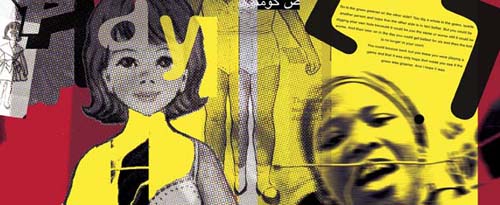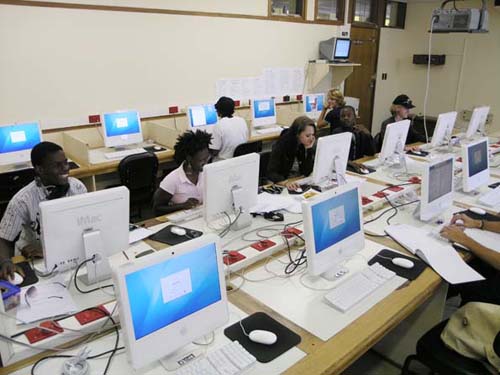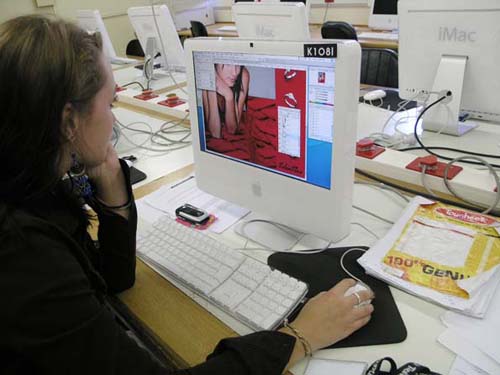Graphic Design Department – Nelson Mandela Metropolitan University

The Graphic Design programme at the NMMU is structured to give you the best balance between essential technological skills, sound academic content and the harnessing of your creative ability. The course is delivered in an studio-like environment which is very similar to what you would experience in the design and advertising industry. This means that there is a high degree of one-on-one interaction between student and lecturer. You can expect a strong emphasis on practical teaching and training which is linked to theoretical academic subjects.
Your fellow students will come from diverse backgrounds and cultures and may include foreign students from all over the planet. Recent students have come from Kenya, Argentina, Netherlands, Sweden, Norway, Zimbabwe and China. Students in the graphic design programme usually develop strong friendships and a good team spirit.
THE WAY WE TEACH
Graphic Design is highly technological and often requires a large degree of computer-based work. While we recognise the importance of technology and its importance within the design industry our focus falls on developing the creative and conceptual thinking ability of our students (we train on Apple Mac computers and have most of the latest software and gadgets too). This teaching approach is supported by teaching the theory of design processes, histories and philosophies of design in combination with practical projects.
Our teaching methodology mimics how design projects and briefs are dealt with in industry – the way you receive and are briefed on projects is almost identical to the manner in which you would be briefed in industry. Often you will be doing work for real clients which means you get real experience in presenting work to clients based on their specific requirements. There is also a strong focus on Reproduction Theory (how to get the idea out of your head and onto paper, television or website) and we address the latest printing techniques and technologies used in the South African design industry.
The Graphic Design programmes will expose you to the following areas of design:
-
Corporate Identity (logos and logo systems)
-
Packaging
-
Publication (magazine and book design and layout)
-
Direct marketing
-
Advertising
-
Promotion
-
Web design (Graphic Design majors only)
OUR EDUCATIONAL GOALS FOCUS ON:
Skills development
The development of technical skills and knowledge of processes, as well as the use of appropriate technology and apparatus. This includes a basic level of computer literacy relevant to individual disciplines.
Creative development
The development of creative thinking and aesthetic understanding, including experimentation, problem identification and solving, and both practical and theoretical application, within a chosen discipline.
Entrepreneurial development
The development of professional business ethics relevant to a chosen career in the visual and tactile arts, including the economics of business, finance, marketing, advertising and self-promotion.
Personal development
Students gain personal confidence in their ability to integrate skills, knowledge and experience relevant to the real-world context.
Enrol in our dynamic graphic design programmes now and enjoy a great university experience that you will remember forever. To setup an interview contact the Faculty Officer or email the the secretary for the Department of Applied Design.
Courses List
- Bachelor of Visual Arts
- BTech (Graphic Design)
- BTech (Graphic Design)
- MTech (Graphic Design)
- MTech (Graphic Design)
UNDERGRADUATE COURSES

Introduction to Graphic Design programmes
We offer full-time Undergraduate Diploma and Bachelor Degree qualifications within the Graphic Design programme, as well as Postgraduate Master’s degrees. In order to obtain a degree you must first complete the Diploma programme (3 years) or already hold a similar qualification.
NB! All students wishing to study Graphic Design at the NMMU must complete a compulsory first year programme which is known as Introductory Studies.
WHAT IS INTRODUCTORY STUDIES?
Introductory Studies is a first year programme that must be successfully completed in order to access the Graphic Design programme.
The number of seats in the Graphic Design diploma programme are limited and therefore access from Introductory Studies (first year) is not automatic. All first year students who apply for enrolment into Graphic Design are required to present a portfolio, at the end of the first year, showcasing all their first year work to an interview panel. Students who have not passed ALL first year subjects will not be considered. Students from other institutions who wish to study Graphic Design at the NMMU are interviewed in the same way.
YEAR 1: INTRODUCTORY STUDIES – FULL-TIME
Introductory Studies subjects:
-
Drawing I
-
Art Theory I
-
Communication I
-
Two-dimensional Studies I
-
Three-dimensional Studies I
YEAR 2: GRAPHIC DESIGN – FULL-TIME
Students who successfully gain entry to the Graphic Design programme may choose to study Graphic Design as single major (you focus only on Graphic Design) or you may split your major into two, in which case you will major in both Photography and Graphic Design (see below).
SUBJECTS INCLUDE:
-
Professional Graphic Design Practice II
-
History and Theory of Graphic Design II
-
Communication Design II
-
Communication Design II Module I
-
Communication Design II Module II OR
- Graphic Design Photography II Module IV
-
Design Techniques II
-
Graphic Design Drawing II
In year two you will be taught Communication Design (Graphic Design) – the fundamentals of Graphic Design and typography (letters), and how to apply them in the context of a brief (set requirements from the client). The primary goal of this subject is to teach you how to create visuals that communicate. In Professional Practice you will learn how to administrate design work, learn about the different printing processes and how to prepare computer work for commercial printing. In the second semester, you will be introduced to basic marketing concepts, how and why markets are broken down into segments, and how to develop marketing plans.
History of Graphic Design is vitaly important because it places Graphic Design styles into context and this, in turn, will allow you to place and create work that fits a particular context. History, as we teach it, deals not only with historic design styles, but also with current styles, approaches and philosophies.
Drawing for Graphic Design requires you to develop a directly applied drawing style that allows you to convey your ideas in a concise and clear manner. This subject is closely tied to Design Techniques, where you are exposed to methods of presenting work, constructing models and working with unfamiliar materials. Important note: Design Techniques includes Photography – this means that students who have enroled for Graphic Design only are also taught the basics of Photography and Art Direction in studio environments.
In many instances you will find thata single design project will also contain mini-projects from other subjects such as Professional Practice. In other words all of the Graphic Design subjects are not separate from one another, but are closely intertwined.
You will be required to produce a portfolio of the years work for examination at the end of the year.
YEAR 3: GRAPHIC DESIGN UNDERGRADUATE DIPLOMA – FULL-TIME
NATIONAL DIPLOMA: GRAPHIC DESIGN
Year three is the final year for students who want to obtain a National Diploma in Graphic Design. Students who wish to continue their studies after year three will have to achieve an average of at least 65% for all third year subjects combined. The subjects in year three are the same as those in year two, but the complexity and depth are increased.
SUBJECTS INCLUDE:
-
Professional Graphic Design Practice III
-
History and Theory of Graphic Design III
-
Communication Design III
-
Communication Design III Module I
-
Communication Design III Module II OR
- Graphic Design Photography III Module IV
-
Design Techniques III
-
Graphic Design Drawing III
Web design is covered in the second semester of the third year. It is important to note that split major students (Photography and Graphic Design) do not participate in the web design module.
In Professional Practice the focus falls on understanding marketing segments and related cultures and sub-cultures. During the second semester you are taught how to write a business plan and related skills.
You will be required to produce a portfolio of the years work for examination at the end of the year.
YEAR 4: GRAPHIC DESIGN UNDERGRADUATE DEGREE – FULL-TIME 1 YEAR; PART-TIME 2 YEARS
BACCALAUREUS TECHNOLOGIAE: GRAPHIC DESIGN
In order to enrol in this programme must have completed the Diploma programme. The Degree programme is known as BTech (Bachelor of Technology) and is an additional 1 year of study following the three year diploma. Entry to the programme is subject to a 65% third year aggregate (all third year subjects combined). You have the option of two qualifications depending on your area of skill and/or research namely:
-
BTech Graphic Design
-
BTech Multimedia
BTech is a combination of compulsory design projects, research essays and a self directed projects (you select a topic or design area to specialise in).
SUBJECTS INCLUDE:
-
Theory of Graphic Design and Academic Report IV (written research documents)
-
Communication Design IV (Graphic Design – books, posters, websites etc.)
You will be required to produce a portfolio of the years work for examination at the end of the year.
POSTGRADUATE COURSES
YEAR 5: GRAPHIC DESIGN POSTGRADUATE MASTERS (2-3 YEARS)
MAGISTER TECHNOLOGIAE: GRAPHIC DESIGN
If you hold a Bachelor qualification in Graphic Design, you become eligible to enrol in the MTech (Master of Technology) programme. Typically a Master’s study will take 2-3 years to complete. There are two Master’s qualifications that you can pursue:
-
MTech Graphic Design
-
MTech Multimedia
The MTech programme contains no compulsory projects or subjects and is self directed research which allows you to specialise in a design related subject area of your choice. In the Department of Applied Design we encourage our Master’s students to use their design knowledge and skills to engage and research issues such as:
-
design in culture
-
socio-cultural issues
-
socio-econmic issues
-
consumerism
-
environmental issues
In other words we guide students to do ‘conscious design’. Work that that has considered its role in society and the world in general.
You may choose to register your research topic as theory only which means that at the end of your study you will submit only a written thesis for examination. Alternatively you can choose to register to submit theory and practical which means that you will submit a written thesis as well as the design work that you produced for the study.
We invite you contact the Department of Applied Design to discuss your options regarding Master’s studies.
OUR FACILITIES
The Graphic Design department provides a classroom per year of study (2nd year, 3rd year, and BTech), while a fully-equipped computer lab houses the latest Apple Mac computers, colour and black and white printing facilities, internet access, and scanners.

Students drawing in the 2nd year class

Students in the computer lab

FINANCIAL AID
Should you require financial assistance in order to study at the NMMU you have several options open to you:
-
A study loan from a financial institution such as a bank
-
NMMU bursaries for students with identified financial need
-
NMMU bursaries for school leavers who have achieved high marks for Matric exams
-
Financial aid for students who require accommodation
For further information contact NSFAS:
- Email: enquiries@nsfas.co.za
- Tel: +27 21 766 3232
- Website: www.nsfas.co.za